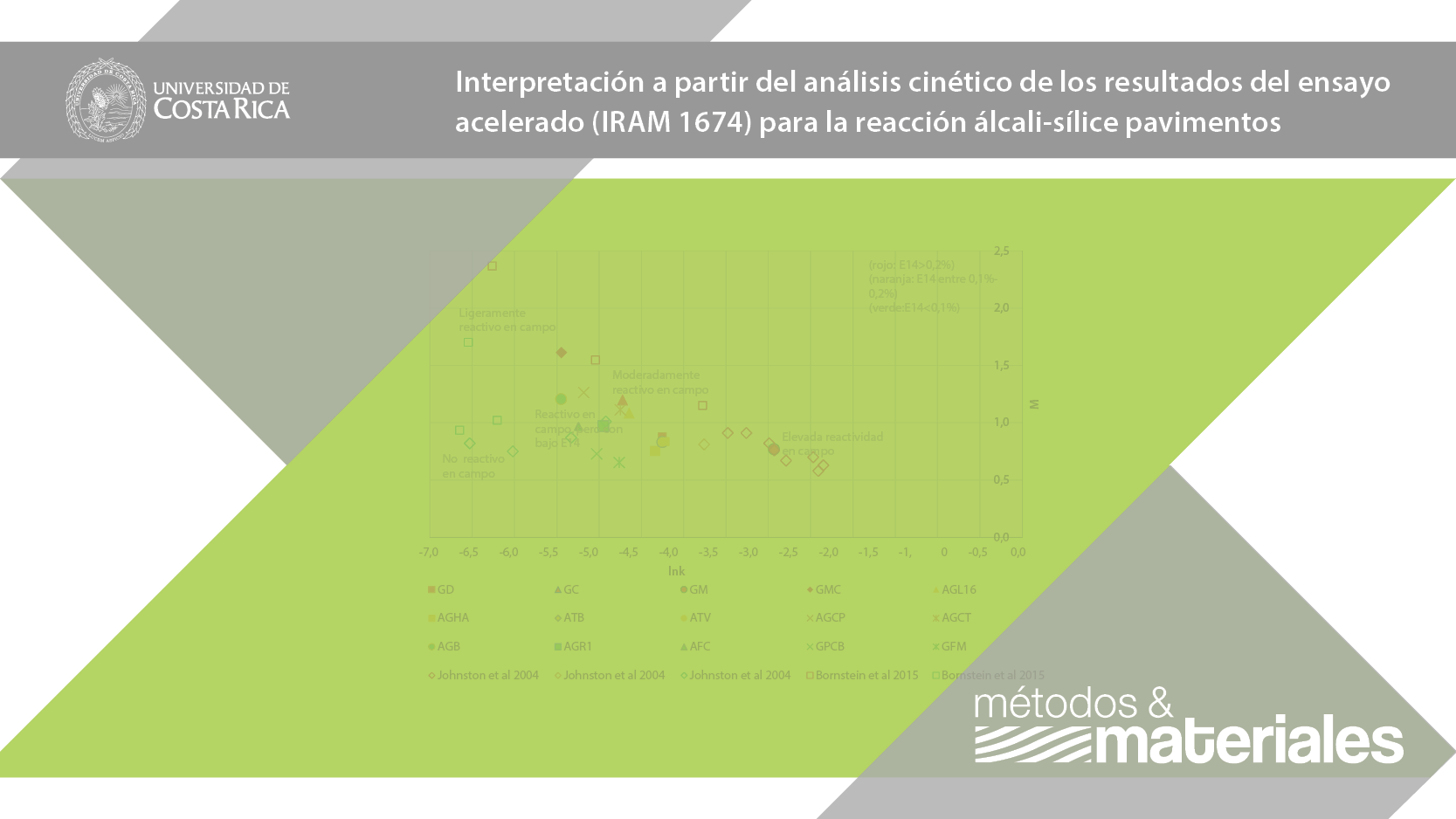Abstract
The expansion of the accelerated test in mortar bars test immersed for 14 days in an aggressive solution (IRAM 1674) as well as the kinetic analysis according to RILEM AAR-2 recommendations for the study of the potencial deleterious of the aggregate in the alkali-silica reaction are presented in this work. The main objective is to contribute to the interpretation of the test results based on the analysis of the growth in expansion with the time of immersion (kinetic analysis) and in this way, get more reliability. The kinetic analysis consists in adjusting by least squares fit of the experimental data of expansion to a known mathematical model (model KAMJ), where the parameters lnk and M are obtained from.
The kinetic parameters lnk and M are associated with the behavior of the reaction. Although a limit value for lnk of -6 is proposed in the literature (lower values are non-reactive aggregates and higher values are deleterious aggregate), from the analysis of the experimental data it was observed that low values of this parameter could be associated with not asymptotic growth of expansion and, therefore, the aggregates presents a deleterious behavior. The lnk/M coefficient is considered a good indicator to evaluate the behavior of the aggregate. However, in order to define a limit value for lnk/M coefficient, it is necessary to establish a correlation with the tests on long-term concrete prism (1 year or more) or the field experience of the aggregate behavior.
References
ABNT NBR 15577-4 (2009), Agregados – Reatividade álcali-agregado. Parte 4: Determição de expansão em barras de argamassa pelo método acelerado. Associação Brasilera de Normas Técnicas, Brasil.
AENOR UNE 146508 EX (1999), Ensayos de áridos. Determinación de la reactividad potencial álcali-sílice y álcali-silicato de los áridos. Método acelerado en probetas de mortero. Asociación Española de Normalización y Certificación, España.
ASTM C1260 (2014), Standard Test Method for Potential Alkali Reactivity of Aggregates (Mortar-Bar Method), ASTM International, West Conshohocken, PA, 2014, www.astm.org.
ASTM C1293-08b (2015), Standard Test Method for Determination of Length Change of Concrete Due to Alkali-Silica Reaction, ASTM International, West Conshohocken, PA, 2015, www.astm.org.
Bronstein, B., Hocking, D., Bacolod, J. Sirivivatnanon., V. (2015). The use of reaction kinetics in classifying alkali silica reactivity potential of aggregates, en Proceddings of the concrete 2015 conference: 27th biennial national conference of the concrete institute of Australia in conjunction with the 69th RILEM week conference, 2015, pp. 704–711. ISBN: 978-1-943847-70-9.
Falcone D., Milanesi, C., Método acelerado del prisma de hormigón. Evaluación de la RAS con agregados de diversas regiones de la Argentina, en el V Congreso Internacional y 19º Reunión Técnica de la AATH, Bahía Blanca, Argentina, 2012.
Ideker, J., Bentivegna, A., Folliard, K., y Juenger, M., (2012). Do current laboratory test methods accurately predict alkali-silica reactivity? ACI MaterialsJournal, 109(4), 395-402.
IRAM 1674 (1997). Agregados. Determinación de la Reactividad Alcalina Potencial Método Acelerado de la Barra de Mortero, Instituto Argentino de Normalización y Certificación, Argentina.
IRAM 1700 (2013). Agregados. Método para la determinación del cambio de largo en prismas de hormigón, debido a la reacción álcali-agregado. Instituto Argentino de Normalización y Certificación, Argentina.
Isam, M., Ghafoori, N., 2013, Evaluation of Alkali-Silica Reactivity Using Aggregate Geology, Expansion Limits of Mortar Bars and Concrete Prisms, and Kinetic Model. Journal of Materials Science Research, Vol. 2, No 2, 103-116.
Johnston, D. y Fournier, B., A kinetic-based method for interpreting accelerated mortar bar test (ASTM C1260) data, en Alkali-Aggregate Reaction, Proceedings of the 11th International Conference, Québec, Canada, 2000, 355–364.
Johnston, D., Stokes, D., Fournier, B.,Surfahl, R. 0y otros (2000), Kinetic characteristics of ASTM C1260 testing and ASR-induced concrete damge, en 12th International Conference on Alkali-Aggregate Reaction in Concrete, Beijung, China, 2004.
Nixon, P y Sims, I. (2016), RILEM Recommendations for the Prevention of Damage by Alkali-Aggregate Reactions in New Concrete Structures, State-of-the-Art Report of the RILEM Technical Committee 219-ACS.
Stokes, D., Concerning the Use of Expansion Data from AST Testing, en Marc-Andre Berube Symposium on Alkali-Aggregate Reactivity in Concrete, ACI International Conference on Recent Advances in Concrete Technology, Québec, Canada, 2006.
UNIT 1050 (2005). Proyecto y ejecución de estructuras de hormigón en masa o armado. Instituto Uruguayo De Normas Técnicas, (Montevideo, Uruguay), p. 288.
UNIT 20 (2017), Cemento pórtland para uso general. Definiciones y requisitos. Instituto Uruguayo De Normas Técnicas, (Montevideo, Uruguay), p. 13.






